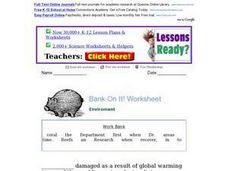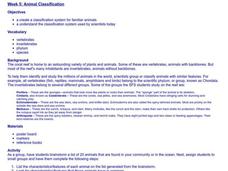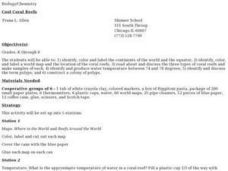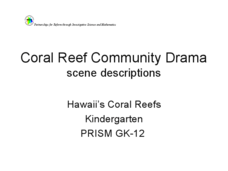Curated OER
A Reef of Your Own
Students study the reproductive strategies of reef building corals. In this coral reef lesson plan students describe the behaviors of reef building corals and their nutritional strategies.
Curated OER
Locating Reefs in Trouble
In this science worksheet, students research where coral reefs are located and which ones are in danger. Students complete a graphic organizer to help organize their information.
Curated OER
Bank On It! Environment
In this science worksheet, students complete a cloze activity about coral reefs. They select words from a word box to fill in the 15 blanks in the article. This worksheet could also be used for reading comprehension in a language arts...
Curated OER
Alien Invasion
Students research how alien species can change an ecosystem. In this coral reef lesson, students describe invasive species and site evidence how these species came to be invasive and what control measures are possible.
Curated OER
Bermuda Reef Diorama
Young scholars build a Bermuda coral reef to gain a better understanding of this ecosystem.
Curated OER
Let's go to the Video Tape!
Using actual data from a deep-sea video survey, high school marine biologists consider the biodiversity, compare species richness between two communities, and learn to calculate the diversity index. The lesson plan is all-inclusive,...
French Teacher
Changement climatique et risque de destruction des récifs coraliens
How is climate change affecting the coral reefs? Advanced French speakers read a half-page text about climate change and what it means for coral reefs. Then, following the reading, they complete a vocabulary activity and discuss the...
NOAA
Community Ecology and Sampling
Seamounts in the Coral and Tasman Seas are home to more than 850 different species. Groups explore hydrothermal vents, researching the organisms found there and their energy source. They also learn about seamounts, exploring their unique...
Project WET Foundation
Discover Our Ocean
A very informative interactive presents ocean zones, estuaries, hot water vents, phytoplankton, coral reefs, sea turtles, kelp forests, and all things that thrive in the ocean.
NOAA
What Killed the Seeds?
Can a coral cure cancer? Take seventh and eighth grade science sleuths to the underwater drugstore for an investigation into emerging pharmaceutical research. The fifth installment in a series of six has classmates research the wealth of...
NOAA
Seamounts
How do chains of islands form? Young oceanographers explore the mountains of the deep in the final installment in a 13-part series. The interactive compares types of seamounts based on their overall height and height under the water, as...
NOAA
Biological Oceanographic Investigations – Call to Arms
How many simple machines does it take to make a robotic arm? An inquiry-based activity explores that topic and challenges pupils to build a robotic arm that can stretch, turn, and more. A few questions help guide them in the right...
Curated OER
Where's My Bot?
Students estimate geographic position based on speed and air travel. In GPS lesson students use GPS to estimate the set and drift of currents.
Curated OER
Sonar Simulation
Students explore how a side-scan sonar can help locate underwater objects. In this hands- on lesson students compare side-scan sonar and other methods used to search for underwater objects by creating their own "simulation" of a...
Curated OER
Conservation and Environmental Protection
Students brainstorm a list of environments and animals from around the world that need protection. They then design and create a slogan about an animal or environment and an environmental protection poster.
Curated OER
Animal Classification
Students list characteristics and features of animals found in their community. They then group the animals according to how they are similar and different and create names for each group. They then create a chart of their...
Curated OER
Ocean Creature Classification
Students develop a Taxonomic Key for marine invertebrates from pictures they are given after practicing together with common objects, such as shoes. They then compare their key to a provided Ocean Invertebrates Taxonomic Key.
Curated OER
Climate
Students study zoanthids. In this science and art lesson, students use line to create texture and how to use colors to create value. Students share their beautiful mat zoanthids with the rest of the class.
Curated OER
Cool Coral Reefs
Young scholars identify, color and label the continents of the world and the equator. They identify and produce water temperature between 74 and 78 degrees. They identify and discuss the term polyps and construct a colony of polyps.
Curated OER
Coral Reef Community Drama: Scene Description
Students are organized into groups and are assigned puppets according to what sea creature their group represents. In this reef lesson, students identify sea creatures according to their place in the food chain then discuss how these...
Curated OER
Oceans Puzzle
In this oceans word search puzzle, students identify terms related to the ocean. Examples include words such as swells, tide, and island. A list of 18 words is provided to assist students in their search.
NOAA
Why is Hawaii's Ocean Important?
Studying the oceans? Focus on Hawaii's ocean with a resource packed with activity-based worksheets. Everything from products that come from the ocean to the abundance of plants and animals that call the ocean their home, Hawaii's ocean...
NOAA
Importance of Deep-Sea Ecosystems – Chemists with No Backbones
Marine invertebrates offer us many new options for developing pharmaceutical drugs, such as w-conotoxin MVIIA, which is extracted from the cone snail and is a potent painkiller. The lesson encourages scholars to research various types of...
NOAA
Invertebrates
Crabs and lobsters ... yum! The 18th installment of a 23-part NOAA Enrichment in Marine sciences and Oceanography (NEMO) program focuses on invertebrate marine life. After the lecture slideshow, learners conduct an activity to sample...
Other popular searches
- Deep Sea Corals
- Corals and Algae
- Corals and Jellyfish
- Corals and Sea Grass
- Endangered Corals
- Reef Building Corals
- Corals 5th Grade
- Endangered Marine Corals
- Corals Subject Review
- Corals Reefs
- Hawaii Corals
- Symbiosis Corals

























